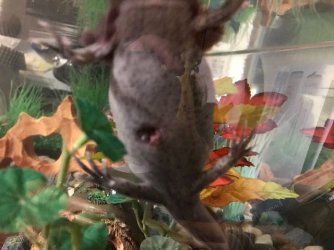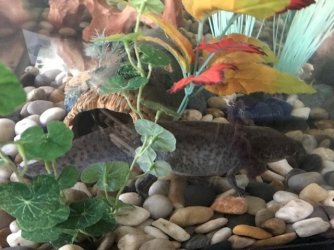Ivander
New Member
Hello,
Can anyone help me understand what to do for our axolotl who has not eaten in weeks, and appears to have a wound in its lower body / stomach area? I am attaching a picture, albeit a poor one. It's quite hard to get him to show me his underside...
We received the axolotl as a gift in December 2019. It was in a 10 gallon tank, so in January we bought a 20 gallon long tank and moved him in February. The tank has some smooth 3/4" river rock as a substrate. A few weeks ago he stopped eating after my wife accidentally startled him by dropping an ice pack in the tank because the temperature had gotten up to 67 degrees F. He stayed hidden in his log for about 3 weeks and just started to come out last week, but rejects all efforts to feed him. Over the last few days he has been more frequently "floating" near the top, but swims to the bottom when I move the water near his tail.
In terms of tank maintenance, I change about 5 gallons of water every week (tap water boiled than cooled for a week). A local pet shop tested a tank water sample and said no problems with ammonia, nitrite, or nitrates, but the pH was low so they sold me some chemical to raise the pH level. The pHvalue continues to be in the 6.6 to 6.8 range. Is there a way I can raise the pH without chemicals?
Any help or suggestions will be much appreciated! We really would like to bring our axolotl back to health
Can anyone help me understand what to do for our axolotl who has not eaten in weeks, and appears to have a wound in its lower body / stomach area? I am attaching a picture, albeit a poor one. It's quite hard to get him to show me his underside...
We received the axolotl as a gift in December 2019. It was in a 10 gallon tank, so in January we bought a 20 gallon long tank and moved him in February. The tank has some smooth 3/4" river rock as a substrate. A few weeks ago he stopped eating after my wife accidentally startled him by dropping an ice pack in the tank because the temperature had gotten up to 67 degrees F. He stayed hidden in his log for about 3 weeks and just started to come out last week, but rejects all efforts to feed him. Over the last few days he has been more frequently "floating" near the top, but swims to the bottom when I move the water near his tail.
In terms of tank maintenance, I change about 5 gallons of water every week (tap water boiled than cooled for a week). A local pet shop tested a tank water sample and said no problems with ammonia, nitrite, or nitrates, but the pH was low so they sold me some chemical to raise the pH level. The pHvalue continues to be in the 6.6 to 6.8 range. Is there a way I can raise the pH without chemicals?
Any help or suggestions will be much appreciated! We really would like to bring our axolotl back to health





